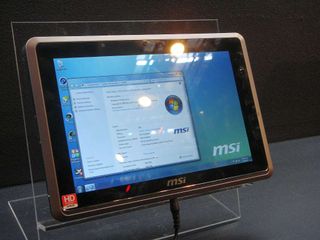Hands on: MSI WindPad review
The tablet goes DirectX 11 with AMD and Windows 7

MSI's Senior Vice President, Henry Lu today showed off it's Windows-powered, AMD-based tablet, the MSI WindPad.
We've seen the WindPad at previous shows but, despite MSI claiming it didn't want to release the product until it felt it had got it absolutely right, it came running Windows 7 and the frankly dubious Intel Atom Z530.
So has it finally got it right with this AMD version?
Well, it's still running Windows 7 and it's tough to tell from the short time we got to play with it, there was no web connection or content to test any of the performance functions, but in general aesthetics it really is a tough machine to fall in love with.
When it was shown on stage our first reaction was that it was rather chunky, and that didn't change once we got our hands on it.
It's rather plasticky too and weighs in at a monstrous 850g - a good 40 per cent heavier than the iPad 2 (the 12.1-inch Asus Eee PC EP121 weighs 1.16Kg).

That said the hardware inside is looking interesting with the AMD Brazos dual core APU (Accelerated Processing Unit), incorporating a HD 6250 DirectX 11 graphics core.
Get daily insight, inspiration and deals in your inbox
Get the hottest deals available in your inbox plus news, reviews, opinion, analysis and more from the TechRadar team.
The Microsoft API allows for some neat acceleration in existing software such as IE9 and the MS Office suite. It's also got a decent 2GB of DDR3 and either 32 or 64GB SSDs to play with depending on your configuration.

That straight 10-inch capacitive screen is now running at a decent 1280x800 resolution and, thanks to that AMD APU, should chew through HD content, both on and offline.
The WindPad also comes with a HDMI port on the side too so you can output that high-def content too.
Unfortunately with great power comes great responsibility... well ok it actually comes with fairly weak battery life. MSI is claiming up to 6 hours.
That's not a great deal of tablet play time to be had then.
There's also a rather large vent on the side of the device, which would indicate the Brazos chip inside needs some not insignificant cooling. In the positively rowdy atmosphere in the hall (a host of AMD-emblazoned ladies were posing for the Taipei paps behind us) it was hard to tell quite how much noise it would make in general use.
With that APU and accompanying 2GB DDR3 it does make for a very responsive machine, though Windows is notoriously awkward when it comes to tablets and touch interfaces so we'll still have to reserve judgement until we get a final machine for serious testing.
And things are getting interesting on the Intel side of the Windows-based tablet argument, too, as we'll discover tomorrow when we get down and dirty with Intel's benchmarking team.
They think they've found the magic bullet to make even Windows 7 an acceptable tablet OS... stay tuned for that.
